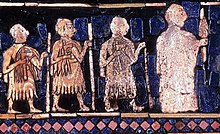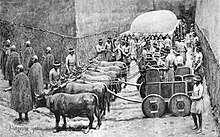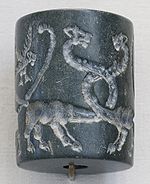ஊரின் முதல் வம்சம்

ஊரின் முதல் வம்சம் (First Dynasty of Ur) பண்டைய அண்மை கிழக்கின் சுமேரியா எனும் மெசொப்பொத்தேமியாவில் உள்ள ஊர் நகரத்தின் முதல் அரச மரபை கிமு 26வது-25வது நூற்றாண்டுகளில் மன்னர் மெஸ்காலம்துக் நிறுவினார்.[1] மெசொப்பொத்தேமியாவின் வரலாற்றின் துவகக் வம்ச காலத்தில் இருந்த ஒரு அரசமரபாகும். ஊரின் முதல் வம்சத்திற்குப் பின்னர் கிஷ் இராச்சியத்தின் முதல் வம்சத்தினர் மற்றும் உரூக்கின் முதல் வம்சத்தினர் சுமேரியாவை ஆண்டனர்.[2]
செமிட்டியர் அல்லாத ஊர் வமிசத்தினர் கிழக்கிலிருந்து கிமு 3,300-இல் மெசொப்பொத்தேமியாவில் குடியேறியர்கள் ஆவார்.[3][4]

[5]]]




சுமேரிய மன்னரகள் பட்டியல்படி, இறுதியாக ஊரின் முதல் வம்சத்தவர்களை ஈலாம் நாட்டின் அவான் வம்சத்தவர்கள் வென்று ஊர் இராச்சியத்தை கைப்பற்றி ஆண்டனர்.[6]
பின்னர் லகாசு இராச்சியத்தினர் கிமு 2500–2400 முழு மெசொப்பொத்தேமியா ஒரு பேரரசாக ஆண்டனர்.[7]
ஊரின் மூன்றாம் வம்ச காலத்தில் (கிமு 2112 முதல் 2004) சுமேரியா மீண்டும் மறுமலர்ச்சிக் கண்டது.[7][8]
முதல் ஊர் வம்ச ஆட்சியாளர்கள்[தொகு]
| ஆட்சியாளர் பெயர் | உருவம் | பட்டப் பெயர் | ஆட்சிக்காலம் | காலம் | குறிப்புகள் |
|---|---|---|---|---|---|
| அ-இம்துகுட் | ? | கிமு 26வது நூற்றான்டு | ஊர் நகரத்தின் அரச குடும்பத்தினர் கல்லறை கல்வெட்டு | ||
| ஊர்-பாபில்சக் |  |
? | கிமு 26வது நூற்றான்டு | ஊர் நகரத்தின் அரச குடும்பத்தினர் கல்லறை கல்வெட்டு | |
| மெஸ்காலம்துக் இராணி புவாபி |
? | கிமு 26வது நூற்றாண்டு | ஊர் நகரத்தின் அரச குடும்பத்தினர் கல்லறை கல்வெட்டு மற்றும் மணிகள் | ||
| அகாலம்துக் |  |
? | கிமு 26வது நூற்றாண்டு | ஊர் நகரத்தின் அரச குடும்பத்தினர் கல்லறை கல்வெட்டு | |
| மெசனெப்பதா | 80 ஆண்டுகள் | கிமு 26வது நூற்றாண்டு | |||
| அ-அன்னெப்தா | மெஸ்-அனே- பதாவின் மகன் | ? | கிமு 26வது நூற்றாண்டு | ||
| மெஷ்-கி-அன்கு-நன்னா |  |
மெஸ்-அனே- பதாவின் மகன் | 36 ஆண்டுகள் | ||
| எலுலு | 25 ஆண்டுகள் | ||||
| பலுலு | 36 ஆண்டுகள் | ||||
| |||||
முதல் ஊர் வம்ச காலத்திய தொல்பொருட்கள்[தொகு]
-
தங்கத்திலான ஆட்டின் சிற்பம்
-
காளையின் தலைச் சிற்பம்
-
விலங்குகளின் ஓவியம் கொண்ட தட்டு, கிமு 2600
இதனையும் காண்க[தொகு]
மேற்கோள்கள்[தொகு]
- ↑ (in en) The Cambridge Ancient History. Cambridge University Press. 1970. பக். 228. பன்னாட்டுத் தரப்புத்தக எண்:9780521070515. https://archive.org/details/cambridgeancient02edwa.
- ↑ (in en) Encyclopedia of the Peoples of Africa and the Middle East. Infobase Publishing. 2009. பக். 664. பன்னாட்டுத் தரப்புத்தக எண்:9781438126760. https://books.google.com/books?id=stl97FdyRswC&pg=PA664.
- ↑ "The Sumerians, a non-Semitic people who perhaps came from the east" in Curtis, Adrian (2009) (in en). Oxford Bible Atlas. Oxford University Press. பக். 16. பன்னாட்டுத் தரப்புத்தக எண்:9780191623325. https://books.google.com/books?id=bTyeXEicBfkC&pg=RA1-PR16.. Mention of Gen 11:2 "And as people migrated from the east, they found a plain in the land of Shinar and settled there." (English Standard Version)
- ↑ Bromiley, Geoffrey W. (1979) (in en). The International Standard Bible Encyclopedia. Wm. B. Eerdmans Publishing. பக். 392. பன்னாட்டுத் தரப்புத்தக எண்:9780802837813. https://books.google.com/books?id=wo8csizDv0gC&pg=PA392.
- ↑ British Museum notice: "Gold and carnelians beads. The two beads etched with patterns in white were probably imported from the Indus Valley. They were made by a technique developed by the Harappan civilization" Photograph of the necklace in question
- ↑ Kriwaczek, Paul (2014) (in en). Babylon: Mesopotamia and the Birth of Civilization. Atlantic Books. பக். 136. பன்னாட்டுத் தரப்புத்தக எண்:9781782395676. https://books.google.com/books?id=xqiWAwAAQBAJ&pg=PT136&lpg=PT136.
- ↑ 7.0 7.1 Incorporated, Facts On File (2009) (in en). Encyclopedia of the Peoples of Africa and the Middle East. Infobase Publishing. பக். 664. பன்னாட்டுத் தரப்புத்தக எண்:9781438126760. https://books.google.com/books?id=stl97FdyRswC&pg=PA664.
- ↑ Knapp, Arthur Bernard (1988) (in en). The history and culture of ancient Western Asia and Egypt. Wadsworth. பக். 92. பன்னாட்டுத் தரப்புத்தக எண்:9780534106454. https://books.google.com/books?id=lHXiAAAAMAAJ.









